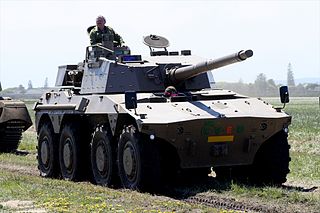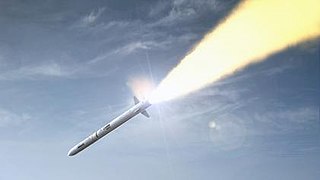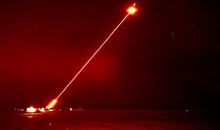
Rapier is a surface-to-air missile developed for the British Army to replace their towed Bofors 40/L70 anti-aircraft guns. The system is unusual as it uses a manual optical guidance system, sending guidance commands to the missile in flight over a radio link. This results in a high level of accuracy, therefore a large warhead is not required.

The Advanced Short Range Air-to-Air Missile (ASRAAM), also known by its United States designation AIM-132, is an imaging infrared homing air-to-air missile, produced by MBDA UK, that is designed for close-range combat. It is in service in the Royal Air Force (RAF), replacing the AIM-9 Sidewinder. ASRAAM is designed to allow the pilot to fire and then turn away before the opposing aircraft can close for a shot. It flies at well over Mach 3 to ranges in excess of 25 kilometres (16 mi). It retains a 50 g maneuverability provided by body lift technology coupled with tail control.

Starstreak is a British short-range surface-to-air missile that can be used as a man-portable air-defence system (MANPADS) or used in heavier systems. It is manufactured by Thales Air Defence in Belfast, Northern Ireland. It is also known as Starstreak HVM. After launch, the missile accelerates to more than Mach 4, making it the fastest short-range surface-to-air missile in existence. It then launches three laser beam-riding submunitions, increasing the likelihood of a successful hit on the target. Starstreak has been in service with the British Army since 1997. In 2012 Thales relaunched the system as ForceSHIELD.

The Missile Transportable Anti-aérien Léger, commonly called Mistral, is a French infrared homing short range air defense system manufactured by MBDA France. Based on the French SATCP, the development of the portable system later to become the Mistral began in 1974. The first version of the system was introduced in 1988 (S1), the second in 1997, and the third in 2018.

A directed-energy weapon (DEW) is a ranged weapon that damages its target with highly focused energy without a solid projectile, including lasers, microwaves, particle beams, and sound beams. Potential applications of this technology include weapons that target personnel, missiles, vehicles, and optical devices.

The Boxer is a multirole armoured fighting vehicle designed by an international consortium to accomplish a number of operations through the use of installable mission modules. The governments participating in the Boxer programme have changed as the programme has developed. The Boxer vehicle is produced by the ARTEC GmbH industrial group, and the programme is being managed by OCCAR. ARTEC GmbH is based in Munich; its parent companies are Krauss-Maffei Wegmann GmbH and Rheinmetall Military Vehicles GmbH on the German side, and Rheinmetall Defence Nederland B.V. for the Netherlands. Overall, Rheinmetall has a 64% stake in the joint venture.

Future planning of the Royal Navy's capabilities is set through periodic Defence Reviews carried out by the British Government. The Royal Navy's role in the 2020s, and beyond, is outlined in the 2021 defence white paper, which was published on 22 March 2021. The white paper is one component of the Integrated Review of Security, Defence, Development and Foreign Policy, titled as Global Britain in a Competitive Age which was published on 16 March 2021.

The Rooikat is a South African armoured reconnaissance vehicle equipped with a stabilised 76 mm (3.0 in) high velocity gun for organic anti-tank and fire support purposes. The Rooikat's main armament was built with the Oto Melara 76 naval gun as its basis, to which it is nearly identical in terms of technical performance and statistics. The Rooikat can also fire the same ammunition as the naval gun, albeit modified with new percussion primers in the shells.

Brimstone is a ground or air-launched ground attack missile developed by MBDA UK for the UK's Royal Air Force. It was originally intended for "fire-and-forget" use against mass formations of enemy armour, using a millimetre wave (mmW) active radar homing seeker to ensure accuracy even against moving targets. Experience in Afghanistan led to the addition of laser guidance in the dual-mode Brimstone missile, allowing a "spotter" to pick out specific and the highest priority targets, particularly useful to minimise collateral damage when friendly forces or civilians were in the area. The tandem shaped-charge warhead is much more effective against modern tanks than older similar weapons such as the AGM-65G Maverick missile. Three Brimstones are carried on a launcher that occupies a single weapon station, allowing a single aircraft to carry many missiles.

Avibrás Indústria Aeroespacial, based in Jacareí, São José dos Campos, Brazil, is a diversified Brazilian company which designs, develops and manufactures defense products and services. Its range of products encompasses artillery and aircraft defense systems, rockets and missiles such as air-to-ground and surface-to-surface weapon systems, including artillery rocket systems; 70 mm air-to-ground systems and fiber optic multi-purpose guided missiles. It makes armoured vehicles as well. It also manufactures civilian transportation through a division called Tectran, telecommunications equipment, electronic industrial equipment (Powertronics), automotive painting and explosives. DefendTex of Australia with possibility to buy the brazilian Defence Company, with a debt of more than R$600 million or some € 80 million, in which R$ 14.5 million is debt with workers.

A laser weapon is a type of directed-energy weapon that uses lasers to inflict damage. Whether they will be deployed as practical, high-performance military weapons remains to be seen. One of the major issues with laser weapons is atmospheric thermal blooming, which is still largely unsolved. This issue is exacerbated when there is fog, smoke, dust, rain, snow, smog, foam, or purposely dispersed obscurant chemicals present. In essence, a laser generates a beam of light that requires clear air or a vacuum to operate.

Abhay was an Infantry Combat Vehicle (ICV) developed under a technology-demonstrator program created in India by the Defence Research and Development Organisation (DRDO). Abhay would serve as the technology demonstrator for the replacement vehicle of the BMP-II ICVs India used at the time, now called the Future Infantry Combat Vehicle Program, and allowed DRDO to experience the indigenous (local) development of nearly the entire ICV and its systems.

The CAMM is a family of surface-to-air missiles developed by MBDA UK for the United Kingdom. CAMM is derived from, and shares some common features and components with, the Advanced Short Range Air-to-Air Missile (ASRAAM), but with updated electronics, a soft vertical launch system, and an active radar homing seeker. The CAMM family is either currently in-use or has been ordered by ten nations.

Martlet or the Lightweight Multirole Missile(LMM) is a lightweight air-to-surface, air-to-air, surface-to-air, and surface-to-surface missile developed by Thales Air Defence for the United Kingdom. It is named after a mythical bird from English heraldry that never roosts, the Martlet.

The Ajax, formerly known as the Scout SV, is a group of armoured fighting vehicles being developed by General Dynamics UK for the British Army. It has suffered serious development and production difficulties.

The Akeron MP, formerly known as MMP is a French fifth generation man-portable anti-tank guided missile system. Featuring a fire-and-forget capability, it also integrates command guidance in both lock-on before launch (LOBL) and lock-on after launch (LOAL) firing modes for visible targets and non-line-of-sight use respectively. The latter two modes incorporate retargeting, i.e. the ability to redirect the missile in flight towards another target such as an unexpected threat or a new and more valuable enemy asset spotted, as well as aim point selection and mission abort features.

The BAE Systems Tempest is a proposed sixth-generation fighter aircraft that is under development in the United Kingdom for the Royal Air Force (RAF). The aircraft is intended to enter service from 2035, gradually replacing the Eurofighter Typhoon. It is being developed as part of the Future Combat Air System (FCAS) programme by a consortium known as Team Tempest, which includes the Ministry of Defence, BAE Systems, Rolls-Royce, Leonardo, and MBDA UK. £2 billion is planned to be spent by the British government on the initial phase of the project up to 2025.
MBDA UK is the British division of the pan-European missile systems company MBDA. Formed in 2001, the company has developed, both independently and in cooperation, a range of missile systems, including the CAMM missile family, Storm Shadow cruise missile, ASRAAM air-to-air missile and Meteor beyond-visual-range missile (BVRAAM).

Challenger 3 (CR3) is a planned British main battle tank in development for the British Army. It will be produced by the conversion of existing Challenger 2 tanks by the British/German Rheinmetall BAE Systems Land joint venture.


















